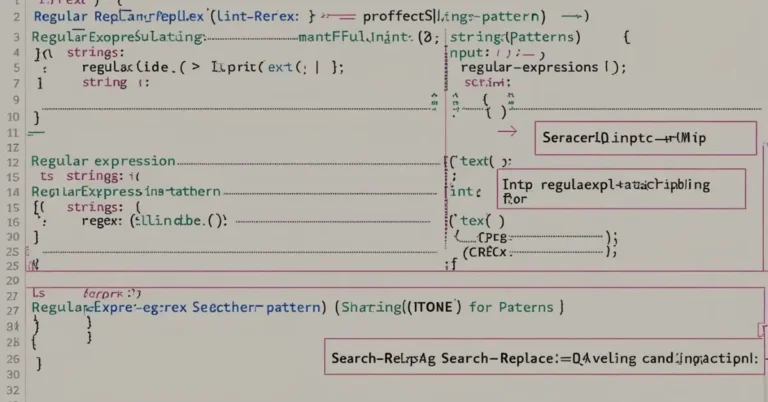Regular expressions, or “regex,” are a powerful, domain-specific language used for parsing, matching, and manipulating text. They are the Swiss Army knife for developers, data scientists, system administrators, and anyone who works with text. A well-crafted regex can replace hundreds of lines of manual string-processing code. However, their concise and symbolic nature can make them notoriously difficult to write, debug, and understand.
This is where Regex101 shines. It’s more than just a testing tool; it’s an interactive playground, a detailed explainer, and a collaborative debugger all in one. This article will explore the core features of Regex101 and answer the most frequently asked questions to help you master the art of regular expressions.
Why Regex101 is the Ultimate Regex Workbench
While most code editors have regex search functionality and many online testers exist, Regex101 stands apart due to its comprehensive feature set, which is neatly organized into several key areas.
1. The Interactive Match Panel
The moment you type a pattern and some test string, Regex101 springs to life. Matching text is highlighted in a calming green, while captured groups are shown in alternating colors (yellow, blue, purple, etc.), making the structure of your match instantly visible.
This real-time feedback is invaluable. You can immediately see if your pattern is too greedy (matching too much text) or too lazy (matching too little), and adjust accordingly. The panel also displays a list of all matches, showing the full match and each individual group, which is perfect for ensuring your grouping logic is correct for extraction.
2. The Decoder Ring: The Explanation Panel
This is arguably Regex101’s killer feature. For anyone trying to learn regex or decipher a complex pattern written by someone else (or their past self!), the Explanation panel is a lifesaver.
It breaks down your regex token-by-token:
\bis explained as a “word boundary.”(https?|ftp)is broken down: a capturing group that matches eitherhttp,https(thes?makes the ‘s’ optional), orftp.:\/\/is clearly shown as matching the literal characters://(note the escaped forward slashes).
This demystification transforms regex from a cryptic incantation into a logical, understandable sequence of instructions. It’s the best way to learn what each part of a pattern is actually doing.
3. The Unit Tester: The Quick Reference and Tests Tabs
Building a complex regex is an iterative process. The Tests tab allows you to save multiple test strings and define what you expect your regex to do. You can create unit tests for your patterns, ensuring that:
- Valid strings are matched correctly.
- Invalid strings are not matched.
- Specific groups capture the correct substrings.
This is crucial for maintainability. If you need to modify a regex later, you can run your saved battery of tests to ensure you haven’t introduced a regression by accidentally breaking a previously working case.
The Quick Reference tab is always visible, providing a handy cheatsheet for tokens, character classes, quantifiers, and flags specific to your chosen regex flavor (PCRE, JavaScript, etc.). No more frantic googling for “regex cheat sheet.”
4. Code Generation and Sharing
Once your pattern is perfected, Regex101 can generate ready-to-use code for your language of choice. Click the “Code Generator” tab, and it will output your regex as a properly formatted string in Python, PHP, JavaScript, Go, or several other languages, often including necessary escaping.
Furthermore, the “Share” button generates a unique URL that captures your entire workspace—your pattern, test string, flags, and even your unit tests. This is fantastic for collaborative debugging. Instead of pasting a messy regex into a Slack channel, you can send a link where your colleague can see exactly what you’re seeing, experiment safely, and suggest fixes.
Putting It All Together: A Practical Example
Let’s say we want to validate and extract details from a URL.
Goal: Capture the protocol, domain, and path into separate groups.
Our Test String:https://www.regex101.com/user/guide/
First Attempt:(https?):\/\/(www)\.[a-z]+\.[a-z]+\/
This works for our test string but is very brittle. It fails for http://example.com/page (no www) or https://sub.domain.co.uk (more than two domain parts).
Refining in Regex101:
We watch the explanation panel and match highlights to improve it.
Final Pattern:^(https?):\/\/([a-z0-9.-]+)(?:\/([a-z0-9\/]*))?$
Let’s break it down with the help of Regex101’s explanation:
^: Asserts position at the start of the string.(https?): Group 1: Captureshttporhttps.:\/\/: Matches the literal://.([a-z0-9.-]+): Group 2: Captures the domain name (e.g.,www.regex101.comorexample.com), allowing letters, numbers, dots, and hyphens.(?:\/([a-z0-9\/]*))?:(?: ... )is a non-capturing group.\/matches a literal/.([a-z0-9\/]*)Group 3: Captures the path that follows.- The final
?makes the entire path section optional.
$: Asserts position at the end of the string.
By using the interactive tools, we’ve built a much more robust and flexible regex and fully understand how it works.
Frequently Asked Questions (FAQs) About Regex101
Q1: Is Regex101 free to use?
Yes, the core functionality of Regex101 is completely free. This includes testing, the detailed explanation, and basic code generation. There is a Pro version that offers additional features like a dark theme, unlimited test cases, ad-free experience, and private patterns.
Q2: What regex “flavors” does it support?
Regex101 supports the most common flavors:
- PCRE (PHP): Perl Compatible Regular Expressions, a very feature-rich flavor.
- JavaScript: Implements the standard ECMAScript regex specification.
- Python: Uses the
remodule syntax. Note that the helper code generator will use Python’s raw strings (r"...") to handle backslashes correctly. - Go: Supports Go’s
regexppackage syntax. - Ruby: Another popular flavor with slight differences.
It’s crucial to select the correct flavor, as features and syntax can vary (e.g., JavaScript does not support lookbehinds of variable length, while PCRE does).
Q3: What do all the flags (like ‘g’, ‘m’, ‘i’) mean?
Flags modify how the pattern is applied.
g(global): Don’t return after the first match; find all matches.m(multiline): Causes^and$to match the start and end of each line within the string, not just the start/end of the entire string.i(insensitive): Case-insensitive matching (e.g.,amatchesaandA).s(single line/dotall): Causes the.metacharacter to match every character, including newlines (\n).x(extended): Ignores whitespace in the pattern unless escaped, allowing you to format your regex with comments for readability.
Q4: What’s the difference between a “match” and a “group”?
A match is the entire span of text that your overall pattern finds. A group (or capture group) is a specific subset of that match, defined by parentheses (). You can have multiple groups within a single match. For example, in the pattern (\d{3})-(\d{3}) applied to 123-456, the full match is 123-456, group 1 is 123, and group 2 is 456.
Q5: What are non-capturing groups (?: ... ) and why would I use them?
Parentheses () inherently capture their content. A non-capturing group (?:) allows you to group tokens together for applying a quantifier (e.g., (?:abc)+) or for alternation without the overhead of capturing and storing the matched text. This makes your regex more efficient and keeps your group list clean, so you only capture what you actually need to use.
Q6: How do I match special characters like ., *, +, or ? literally?
You must escape them with a backslash \. So, to match a literal period, you use \.. To match a literal backslash, you use \\. Regex101 will highlight escaped characters differently in the pattern field to remind you.
Q7: The tool says my regex is “catastrophic” or prone to “redos.” What does this mean?
This is a critical security feature. ReDoS (Regular Expression Denial of Service) is an attack where a maliciously crafted string can cause a poorly designed regex to take an extremely long time to evaluate, hanging an application. This often occurs with nested quantifiers (e.g., (a+)+). Regex101 will warn you about these patterns. You should heed this warning and refactor your expression to be more specific and efficient.
Q8: Can I save my regex patterns on the site?
Yes, but this is a feature of the Pro version. Free users can use the “Share” link to preserve a specific regex and its test cases, but cannot save them to a personal library within the site without the link.
Q9: My regex works in Regex101 but not in my [Python/JS/PHP] code. Why?
This is almost always due to one of two reasons:
- Incorrect Flavor: You tested in PCRE but your code is running in JavaScript, which has different supported features.
- String Escaping: In your code, the backslash
\is also an escape character. The pattern\bmust be written in a Python string as"\\b"or, better yet, in a raw string asr"\b". Always use the “Code Generator” tab to get the correctly escaped string for your language.
Q10: What are some best practices for writing maintainable regex?
- Use the
xflag: It allows you to add comments and whitespace to explain complex parts of your pattern. - Leverage the Tests Tab: Create a suite of test cases for valid and invalid inputs.
- Use Named Groups: In supported flavors (e.g., PCRE, Python), use
(?P<name>...)to give your groups meaningful names like(?P<protocol>https?)instead of just remembering that$1is the protocol. - Start Simple: Build your regex incrementally. Get a small part working, test it, and then add more complexity.
- Don’t Over-Regex: Sometimes, a simple string split or a few lines of procedural code are clearer and more maintainable than a monstrously complex regex.
By integrating Regex101 into your workflow, you stop fighting against regular expressions and start harnessing their full power with confidence and clarity.

